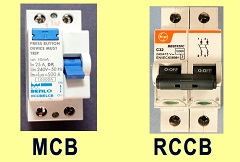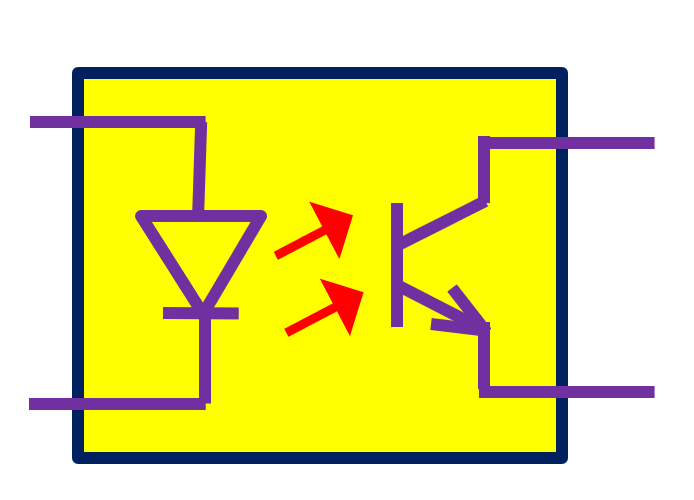We will discuss the difference between MCB (Miniature Circuit Breaker) and RCCB (Residual Current Circuit Breaker) types of circuit breakers. MCB (Miniature Circuit Breaker) and RCCB (Residual Current Circuit Breaker) types of circuit breakers are used for electrical protection purposes in homes and industries.

MCB and RCCB circuit Breakers – the main difference
We use the MCB (Miniature Circuit Breaker) and RCCB (Residual Current Circuit Breaker) types of circuit breakers for electrical protection purposes in homes, offices,s and industries.
We use both types of circuit breakers for protection purposes, but there are many differences between them.
The main difference between MCB and RCCB breakers is that MCB is used for over-current and short-circuit protection, but RCCB is used for the safety of humans and machines. However, there are a few other differences between the MCB and RCCB circuit breakers also.
The differences between MCB and RCCB circuit breakers are as follows
1 – Function difference between MCB and RCCB
MCB is designed to protect electrical systems from over-current and short circuits.
RCCB circuit breakers also known as RCD (Residual Current Device), provide protection against electric shock and leakage in electrical appliances. RCCB breaker detects small leakage currents that can occur when a person comes into contact with live parts. It also detects leakage current faults in the wiring or appliances.
2 – Current sensing mechanism in MCB and RCCB breaker difference
The MCB circuit breaker has thermal and electromagnetic magnetic sensing. The thermal mechanism responds to sustained overloads, while the electromagnetic mechanism responds to short-duration high-current events.
While the RCCB circuit breaker has only electromagnetic sensing of the current.
3 – Sensing current signal difference between MCB and RCCB breakers
The MCB senses the current flowing in the line and neutral wire and provides protection if any one of these currents becomes more.
While RCCB senses the current difference between the line and a neutral wire in the electrical circuit,
RCCBs use a differential current transformer to sense the difference in current between the live and neutral conductors.
However, the electrical contacts of the RCCB breakers are designed for the full load current.
4 – Current sensitivity
Another difference between MCB and RCCB breakers is that, the RCCB breaker is more sensitive to current measurement compared to the MCB breaker. This is due to the fact that the RCCB breaker needs to sense a small value current of the order of a few mA (the difference between line and neutral wire current).
If the difference in electrical current in the line and neutral wire exceeds a certain threshold (usually 30 mA, 100 mA, or 300 mA), it indicates a leakage or fault and triggers the RCCB to trip.
By quickly detecting such leakages, RCCBs help prevent electrical shocks and potential electrocution.
5 – Tripping time difference of MCB and RCCB breakers
The MCB has two types of sensing, thermal and electromagnetic. The response of thermal trip is slow as it depends on the heating of the BI-METAL element. As it is a mechanical process, it will work slowly compared to the electromagnetic method.
The thermal protection response time also depends on current flow, it will operate fast for large currents.
The RCCB and MCB both have electromagnetic-type sensing also.
Electromagnetic sensing is quite fast. However, the time required to trip the RCCB depends on the current rating and the amount of electrical leakage current (difference between line and neutral current) flowing.
The tripping time is less for the large electrical leakage current.
6 – Applications
Generally, both MCB, as well as RCCB circuit breakers, are connected in an electrical circuit to protect the system and human safety.
We use the MCB circuit breakers in residential, commercial, and industrial applications to protect electrical circuits and electrical devices from overloads and short circuits. They are suitable for the general electrical protection needs of the electrical system.
RCCB circuit breakers are used for personal and electrical shock protection as well as for protecting electrical equipment from leakage currents.
It is necessary that we use RCCB circuit protection circuit breakers in our homes for safety reasons and also MCB for over-current protection.
RCCBs are also used in industry to protect equipment from electrical leakage and faults in wires etc.
RCCBs are essential for ensuring electrical safety and compliance and regulations.
Extra knowledge as per Experience
We always use MCB and RCCB circuit breakers together in our homes.
The MCB circuit breaker may be connected before the RCCB circuit breaker in the electrical circuit.
We used many MCB breakers in my industrial equipment design depending on the application. However, we did not use RCCB breakers inside the individual electrical control or power electronics equipment. Instead, there were separate protection panels for the whole electrical system.
There may be many MCB circuit breakers for a single piece of equipment, but there may be only one common RCCB breaker for many pieces of equipment. However, there is no harm in using many RCCB breakers.
Further, if we decide to use many RCCBs due to differences in rating in the equipment, then we should connect a common RCCB with more current along with a few small leakage current rating RCCBs for individual equipment.
One single RCCB breaker is sufficient for a set of equipment for the electrical system. However, in the complex system, there are many protection features instead of just the RCCB breakers in the industry.
Sometimes the MCB and RCCB circuit breakers are into a single device called an RCBO (Residual Current Circuit Breaker with Overcurrent Protection).
The RCBO provides both overcurrent protection and residual current protection in a single unit.
For more detailed information on the MCB RCCB breakers difference, watch the video below:
I hope that you enjoyed reading the article on the topic, of the difference between MCB and RCCB circuit breakers.
If so, then subscribe to my YouTube channel.
Further, read about the AFDD circuit breaker.
Continue reading about open-circuit current transformers.
Also, read AC or DC power which is more dangerous.
Further reading How to check transformer at home?
Also, read the differences between open and closed-loop control.
About the author – G K Agrawal B.Sc and B.Tech (from HBTU Kanpur), Retd. Sr DGM Design (BHEL), the inventor of patents, has lifelong industry experience in the electrical and electronics design field of R&D. He worked for BHEL. He shares his experience and knowledge on blogs and YouTube. Read the profile here.



Very good information.
Thanks